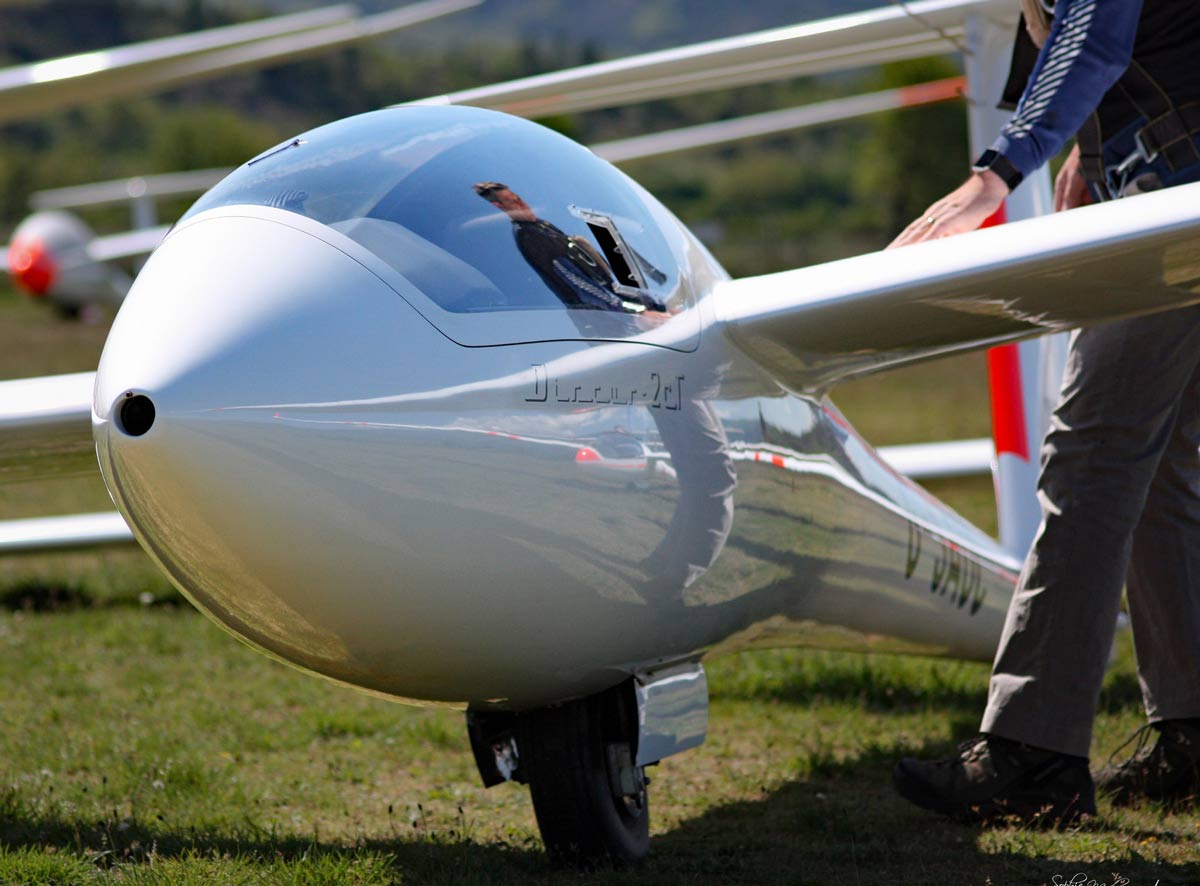Buying a Glider 101

Honey, I need a new glider!
So, you are in the market for your own glider! No more hoping a club one will be available when you show up at the airport. You can take it away from the home airport for contests, or to experience different soaring sites and learn about wave and ridge soaring. Sounds wonderful, however buying any aircraft is quite different than buying a car, boat, or motorcycle. First off, aviation is a highly regulated world. For someone not used to it, it can be frustrating. Just remember, the regulations are there in an attempt to provide a high level of safety to you. There is a reason that each one was made, whether it makes sense to you or not. Odds are you will be looking at a used aircraft, probably fiberglass but there are tube and fabric and sheet metal gliders out there.
The one that we have’s obsolete
You have done your research on performance, price range shopped and located one for sale that will fit your purposes and budget that is not too far away. You are driving some distance to go look at it, what should you look for?
Do a pre-pre buy
First off, before leaving home search for a pilots' operating manual online and read it to get familiar with the aircraft. Go to the FAA website and search for a list of Airworthiness Directives applicable to that serial number aircraft. If it is an FAA certified airframe then download a copy of the Type Certificate Data Sheet (TCDS) from the FAA website. This document tells you what is required for the aircraft to be legal. Things like airspeed markings required instruments on board, weight, and balance info. At the annual inspection, the aircraft must be in compliance with the TCDS for the Inspector to sign it off as airworthy. Obtain a copy of the aircraft logbooks if possible. Nowadays most people will scan them and send you an electronic copy for you to review. Find a knowledgeable friend or pay an A&P you trust to go through them. Check total airframe time against the manufacturer's time of life-limited parts. Some manufacturers require additional inspections or ground the airframe at certain total hours. Look for any damage history or structural repairs. Look at airframe times and annual inspection dates over the life of the aircraft. 7 consecutive years of no annuals means it sat in the trailer unused and may have been home for rodents for a time. Depending on climate it may have mold growing on the airframe. Check for Airworthiness Directive compliance in the logbooks. If fiberglass, determine if it has factory original gelcoat or has it been redone at some point. If fabric-covered then determine the age of the current fabric covering. Something you find wrong here might save you a road trip to go look at an undesirable purchase.
Show up with the paperwork ready
Obtain and take the following blank paperwork with you. You will need it in order to conclude a purchase.
- FAA form 8050-2, 3 copies, aircraft Bill of Sale. One for you, one for the seller, one for FAA
- Generic or state-provided Bill of Sale for a trailer may need it to register the trailer in your state.
- Aircraft Sale Agreement, AOPA has a good fill in the blank generic one.
- Aircraft Registration Application FAA form 8050-1.
What to look over first
Let us assume it has passed your paperwork review up to this point and you are headed out to see it this weekend. You have a toolbox in the trunk and stars in your eyes. When you get there, most likely it will be in a trailer. Pulling it out and assembling it with the owner is a great way to get to know it. Verify the airframe Serial Number on the aircraft matches the Serial Number listed in the logbooks. If they do not, it is a problem. Snatch a sniff at the interior. Does it smell like mouse droppings? Verify the presence of the required paperwork; valid airworthiness certificate that matches aircraft serial number, registration showing correct serial number and the guy selling it is the owner, operating manual issued by the manufacture to this serial number airframe, (prior to mid-1970s, it may not have an operating manual issued to the specific aircraft serial number. It may be a generic one applicable to the fleet.), latest weight and balance record accomplished within the time frame mandated by manufacture. Check any metal parts for corrosion, especially if it has been living near the coast or any other high humidity area. Aluminum aircraft should be examined at all inspection plates for corrosion. Given the age, you would expect to see light surface corrosion. If you find more, then walk away or get an A&P involved to determine appropriate action and cost estimate, then negotiate. Charge the batteries and turn on all avionics and verify operation. Compare the placards and instrument markings in the cockpit to the Pilots Operating manual and make sure they are correct. Someone might have replaced a faulty airspeed indicator with one they got from their buddy at another club, where it had been sitting on a shelf unused. However, it came from a totally different glider and the white, green, yellow, red, airspeed markings are totally incorrect for this glider. After assembly check all control functions looking for smoothness, correct operation, positive control check. No sloppiness or rattling rudder cables. Do a detailed walk around looking for anything unusual. Then step back from the aircraft, 30 feet or so, and walk around it to look for obvious stuff you missed because you were up close assembling it and checking the other stuff I mentioned. Here is where you may notice the tire is low, the canopy seam is off and doesn't fit right, contest markings are different on the left and right side, the horizontal stabilizer seems to be a couple of shades different in color... you get the point.
Specifics for fiberglass gliders
For fiberglass gliders pay attention to the gelcoat or polyurethane as refinishing a glider is an expensive proposition. Most gliders on the used market came out of the factory with gelcoat. It is a great finish but eventually, it will craze and crack one day. Try to find out if the owner regularly waxes it, and how it is normally stored. Moisture and UV from sunlight are the big enemies of a gelcoat finish. Even with some crazing, a gelcoat finish will last much longer than you would expect if just a few steps are made to take care of it. (See Andy Breyer’s Wings & Wheels article from 1/2/2020) If the finish is particularly old, more care should be taken to consider the environment where it lives compared to where you will take it. Moving something from the coast to the desert or vice versa could accelerate the aging process of an older finish. You may instead have a polyurethane finish. Polyurethane is more difficult to touch up or fix when it gets damaged but is otherwise an extremely long-lasting finish. It does not craze overtime like gelcoat, but it can still turn a little yellow.
For older “More distinguished” sailplanes
For tube and fabric, gliders verify how old the fabric is and how it has been stored since the last recover job. Given the quality of the modern fabric materials, if properly stored, it can last longer than the steel tube airframe it covers. Then the issue becomes corrosion in the steel tubing of the airframe. Use a strong flashlight and mirror to examine the steel tubing you can see for surface corrosion. Pay attention to lower areas where water can drain or accumulate. There is a tool for checking the fabric strength called a punch tester. Using it untrained and on someone else’s aircraft is problematic because it can leave a hole punched in the fabric if improperly used or if the fabric is weak. Do not hesitate to get a qualified A&P involved to evaluate it if there are any questions.
Test flight? I don’t even know you!
Test flights are common with powered aircraft, however, the owner of a single place glider is understandably reluctant to release their aircraft for flight by someone they do not know, so test flights are not common in my experience. This makes the pre-purchase inspection even more important.
Finishing up the transaction
So, you have found your glider, accomplished a pre-purchase inspection, negotiated with the seller, and made a deal. Make sure you get it in writing. AOPA has an aircraft sales contract online that is a generic fill in the blank version which simplifies things, just use the portions you need. It will walk you through things to consider and document in your agreement. It also prevents misunderstandings. When money changes hands complete the FAA Bill of Sale and have the seller sign all copies. Make sure he uses the correct title. If it does not match what is on file it can cause extensive delays in Oklahoma City. Once you have closed on the aircraft, fill out the FAA aircraft registration form. Follow the directions and send both FAA forms to Oklahoma City.
The first one will be here in May!
Congratulations, you are now an aircraft owner and caretaker of a machine that will give you incredible experiences and on which your life depends. The Federal Aviation Administration regulations make you, the aircraft owner responsible for the maintenance decisions on that aircraft. Yet there is no training for it. You must keep it legal, safe, and airworthy. Your life depends on it as well as anyone else’s who might fly it while you own it. Always be learning about your aircraft. Do not guess what’s right, this is aviation, it is documented somewhere as to how it should be. There is no shortage of experienced people willing to share their knowledge to help a new aircraft owner.
Flying aircraft, and more so gliders, is a lot of work, however, it is worth the effort because of the tremendous and unparalleled rewards it offers. Now go have fun!
(Ed note: Apologies to Ed Kilbourne, who’s soaring music I have loved since I was 14 and used while writing the paragraph titles)
Banner photo was taken by Sophie Mahieu










